The Art of the Shadow: How Painters Have Gotten It Wrong for Centuries
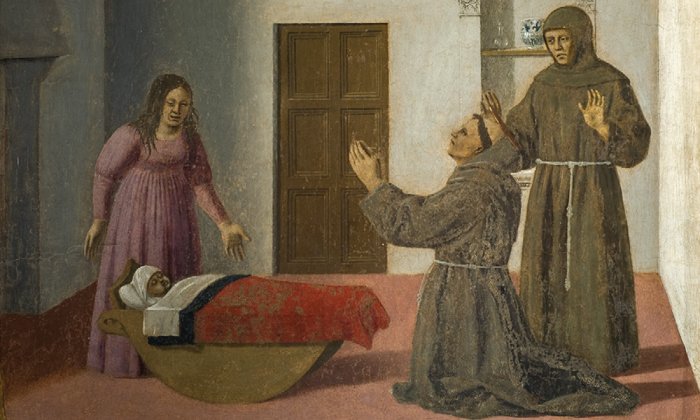
Shadows can do some adventurous, sometimes malignant, poetic things: They move, rebel, hide, refuse to be identified, vanish. All these visual aspects provide fertile ground for complex metaphors and narrations. Shadows are so visually telling that it takes little to move into emotionally tinged narratives. But it is the visual aspects that we primarily deal with here, with a special focus on several types of misrepresentations of shadows — shadows doing impossible things — that nevertheless reap a payoff for scene layout and do not look particularly shocking.
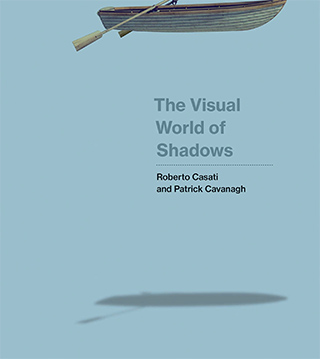
Painters have long struggled with the difficulties of depicting shadows, so much so that shadows — after a brief, spectacular showcase in ancient Roman paintings and mosaics — are almost absent from pictorial art up to the Renaissance and then are hardly present outside traditional Western art.
Here, we embark on a journey that takes us through a number of extraordinary pictorial experiments — some successful, some less so, but all interesting. We have singled out some broad categories of solutions to pictorial problems: depicted shadows having trouble negotiating obstacles in their path; shadow shapes and colors that stretch credibility; inconsistent illumination in the scene; and shadow character getting lost. We also find some taboos, that is, self-inflicted limitations on where or what to depict of a shadow.
Because we do not notice them, transgressions of physics reveal that our visual brain uses a simpler, reduced physics to understand the world.
Some of the shadow oddities in our tour are scientifically remarkable, as they suggest that painters discovered important shortcuts in representing three-dimensionality. Importantly, painters point out the visual system’s peculiar tolerance for physically impossible shadows, as well as an occasional intolerance of quite possible shadows. Some other oddities simply indicate the difficulty in solving a representational problem but are interesting nonetheless. In general, most of the cases we examine involve radical simplifications of the physical aspects of the represented scene and reveal a (relative) tolerance in the human visual system for these simplifications. In most cases, detecting these odd physical aspects requires careful observation, which indirectly proves the thesis we are making: that some pictorial shortcuts are indeed effective. Spotting impossibilities in a picture with shadows is not like quickly noticing that something is wrong with the Reutersvärd-Penrose impossible triangle. So although we are perplexed by some impossible solid objects, we seldom notice equally implausible shadows.
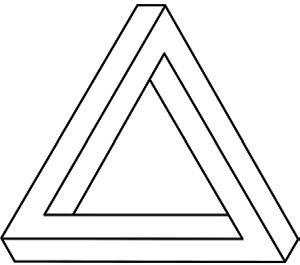
In many cases, the rules of physics that apply in a real scene appear to be optional in a painting; they can be obeyed or ignored at the discretion of the artist to enhance the painting’s intended effect. Some strong deviations, such as Picasso’s skewed faces or the wildly colored shadows in the works of the Fauvist school, are meant to be noticed as ingredients of the style and message of the painting — they serve communication purposes. On top of that, an alternative physics operates in many paintings, one that few of us ever notice but is just as improbable. These transgressions of standard physics — impossible shadows, impossible colors, impossible reflections or contours — often pass unnoticed by the viewer and do not interfere with the viewer’s understanding of the scene. Because we do not notice them, transgressions of physics reveal that our visual brain uses a simpler, reduced physics to understand the world. Artists can endorse this alternative physics precisely because these particular deviations from true physics do not matter to the viewer: The artist can take shortcuts, presenting cues more economically and arranging surfaces and lights to suit the message of the piece rather than the requirements of the physical world. In discovering these shortcuts or strategies of image compression, artists act as research neuroscientists or as visual hackers, and we can learn a great deal from tracing their discoveries. The goal is not to expose the “slipups” of the masters but to understand the human brain. Art in this sense is a type of found science — science we can do simply by looking.
Shadows Meet Obstacles: How Do They Behave?
Masaccio: Carpet shadows
Shadows enhance realism, but they are difficult to depict. Painters interested in shadows moved one step at a time, by trial and error, testing the limit of the tolerance of the visual brain. The strategy pays off insofar as a large tolerance of impossibility simplifies the painter’s work. An intriguing example concerns the interaction of cast shadows with objects that may be placed in between the object casting the shadow and the larger intended projection screen (the ground or a wall). In Masaccio’s “Tribute” in the Brancacci Chapel in Florence (fig. 1), well-delineated (and in this sense quite exceptional for their time), complete shadows of the various characters appear to be cast on the ground, without falling on any of the people who should intercept them. We call these “carpet shadows,” as they can be walked over like carpets.

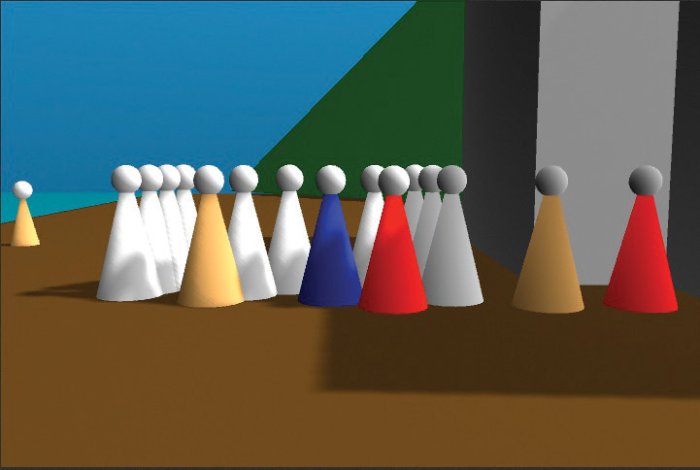
In the simulation by Meeko Kuwahara (fig. 2), we see what the patterns of Masaccio’s shadows should have looked like. We may speculate about whether Masaccio did not have the resources for depicting the shadows correctly, or whether he chose not to depict them on bodies for aesthetic reasons. Whatever the case, the tolerance for carpet shadows is an intriguing discovery.
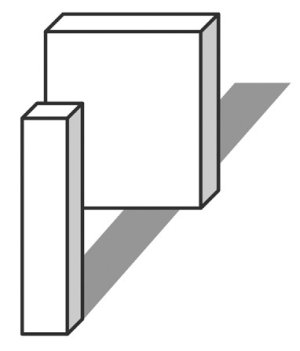
A powerful example of a carpet shadow appears in a painting by Konrad Witz (fig. 3). One possible interpretation of the image is that the shadow of an implement is cast on the floor — and spares Saint Catherine, either stopping at her dress or stopping and then reappearing behind her. According to some observers, the triangle-shaped shadow to Catherine’s left is relatable to the shadow arriving from the bottom right (this would represent one of the rare access shadows found the artistic corpus). In any case, the shadow in the bottom right corner stops mysteriously at the saint’s dress. What happened?

Everybody’s problem: Physical edges and chopped shadows
There is more. Carpet shadows vanish and then reappear beyond the bodies they spare. In contrast, “chopped” shadows just stop and vanish when they reach a surface where the continuation of the shadow shape and color would create pictorial difficulties for the painter. (Note that these physical implausibilities do not destroy the shadow character of either carpet or chopped shadows.) Surface discontinuities, in particular corners where two walls meet or where the floor meets a wall, create a technical barrier to shadow representation. Already in Piero della Francesca’s work, shadows get truncated at surface discontinuities (fig. 4). These discontinuities typically correspond to a double possible luminance change, in either reflectance (a floor and a wall) or illumination (the two surfaces that meet are oriented differently relative to the light), or both, making it hard for the painter to compute and adjust the reflectance of the pigment for the shadow depiction.

Shape recalculation is a complex task, too: when it meets a concave or a convex corner, the shadow boundary changes direction in the image (unless the light source coincides with the viewpoint, or unless there are accidental alignments, for instance, if a change in direction in the shadow-casting rim of the object is projected precisely at the corner in the appropriate way). In what follows, we will see a number of attempts at coping with these problems — in some cases, just avoiding them; in others, coming up with arbitrary, more or less satisfactory shortcuts.

The threat of inconsistency does not appear to be a strong deterrent. In Lucas Cranach The Elder’s “Der Sterbende” (fig. 5), the shadow of one of the two characters does, and the other does not, climb the vertical surface once it reaches it.
There is no obvious explanation for the climbing taboo. The painter could easily diminish the cast shadow (reducing it to a small anchoring shadow near the feet, for example) so that no abrupt interruption would occur farther on where the two surfaces meet. In some cases, as the interruption coincides with a physical discontinuity, the shadow risks losing its shadow character; but this does not usually happen. On the other hand, loss of shadow character threatens shadows that are not made to turn around corners, which may explain why, while some shadows do not bend at corners as they should, others are depicted turning around corners, some correctly, some not.

In natural situations, shadows do bend at corners, if the object casting the shadow is in a suitable position (fig. 6). Painters have observed and depicted shadows that climb steps, bend around corners, and climb up walls (fig. 7).
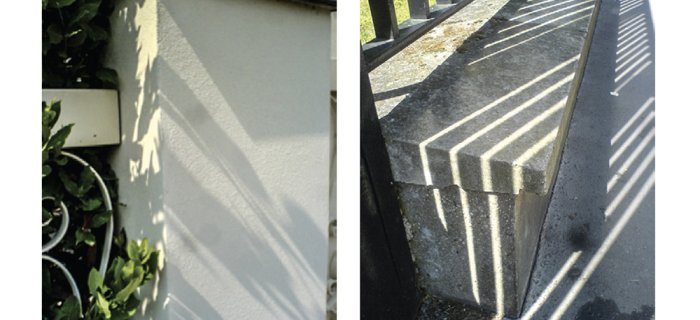

In yet other cases, the painter simply neglects the structure of the projection surface. In Girolamo Genga’s “Immacolata Concezione”(fig. 8), a spike shadow — already a poor approximation of the object’s figure — fails to adapt to the shape of the steps. Depicting a shadow correctly climbing steps does not guarantee that it is not abruptly truncated. Even Raffaello helps himself to this shortcut (fig. 9).
Finally, in the staircase depicted by Biagio D’Antonio (fig. 10), we see a shadow whose lower half is truncated. It does climb up the wall, but how did it get there? The corner taboo seems to be confirmed in both directions: Shadows get to the foot of the wall and stop there, or they climb the wall without getting there.
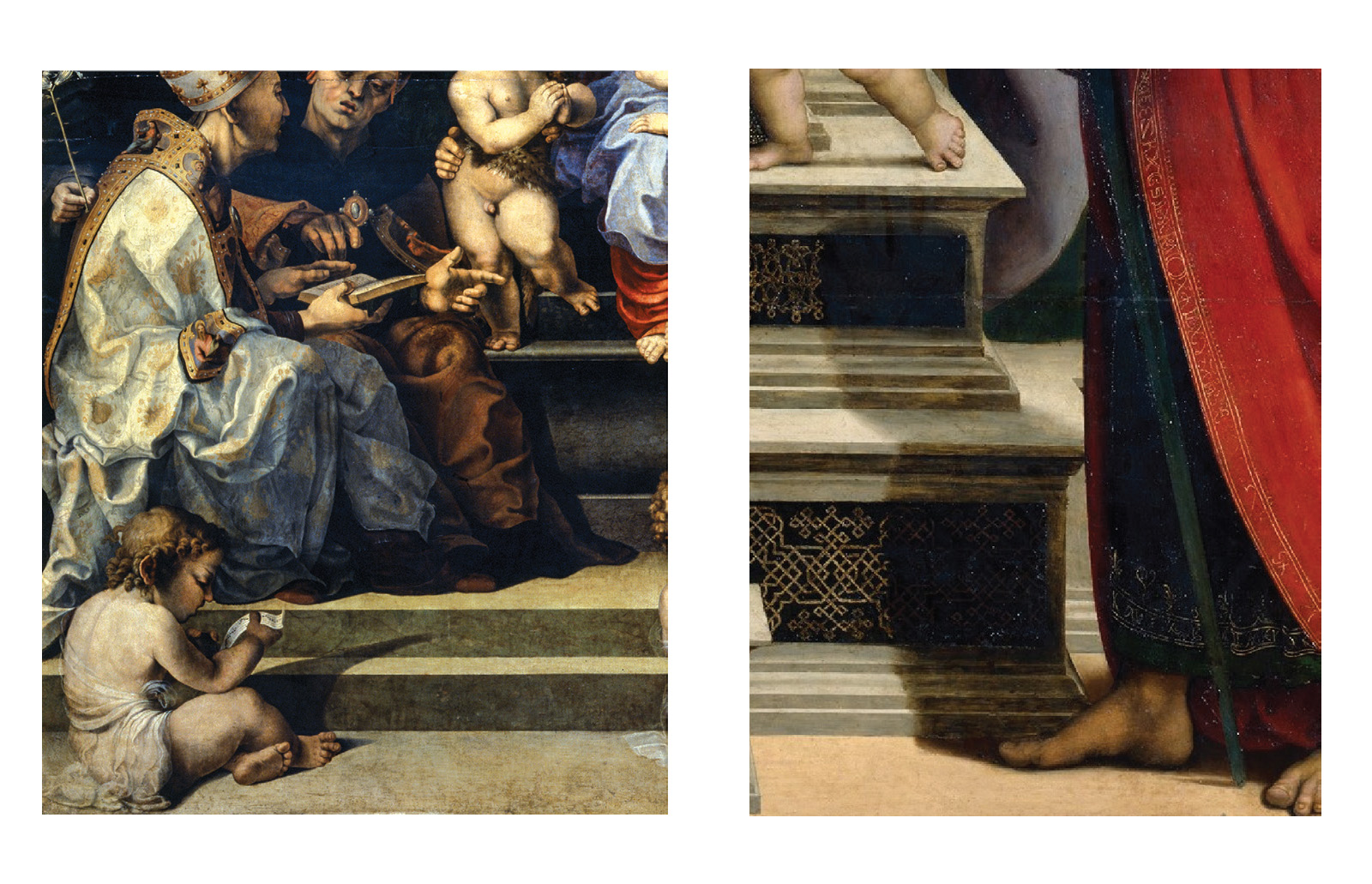
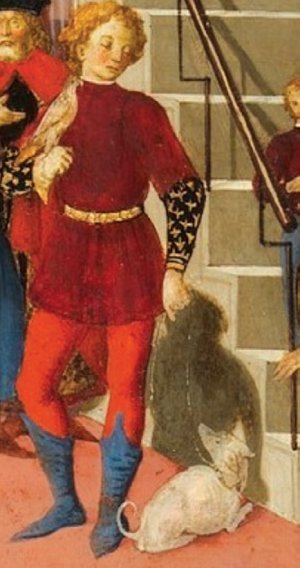
The Witz experiment: Shadows that bend around corners
If some shadows do not climb walls and should, others turn around corners — and should not. The problem with corners and walls is that surfaces impose constraints that are not respected by some shadows. In Konrad Witz’s four large paintings for the Saint Pierre Cathedral in Geneva, we see a number of shadows systematically bending abruptly around corners. For instance, in the Adoration of the Magi (fig. 11), the shadow of the Virgin’s head bends around the corner of the house. A trade-off between recognizability of the object casting the shadow and geometric accuracy has been resolved in favor of the former. Bent shadows also show up in the niche above the main doorway, where the statue of a character playing the harp is located.

Another painting in the series is “The Deliverance of Saint Peter.” The general pattern is the same as in the “Adoration.” Above the doorway, a niche hosts a statue of a character holding a six-pointed star that bends around the corner of the niche (fig. 12). It is clear that Witz was convinced by the solution. Note that the bend is clearly signaled by a change in the direction of the terminator; the shadows are not full-blown copycats. It is thus possible that the main visual effect sought here is the enhancement of the corner.

Witz’s example is particularly telling because of his association with naturalism and careful observation of physical phenomena, in particular phenomena related to light — shadows, reflections, transparencies. The “Adoration” is depicted on the interior panel of a triptych, one of whose exterior wings, “The Miraculous Draft of Fishes,” is alleged to be one of the first representations of a real landscape: Lake Leman, with Le Môle and Mont Blanc in the background, displaying impressive details of bubbles on water, transparencies, and underwater objects.
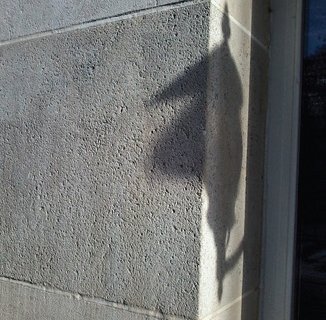
Although Witz’s experiments with bent shadows are not completely accurate, they depict possible shadows. Other artists were not so careful and produced shadows that bent impossibly around corners. For example, an impossible bending is seen on the shadow of a column in a painting by the Master of Alkmaar (fig. 13). Here, as earlier, we should observe that physically incorrect as they may be, shadows that bend or stop at corners still perform their surface-enhancing function: By the change in direction of their boundary, they signal the presence of a corner.

The Shape and Color of Shadows
What are the shape and color of shadows? Does the eye care? Did painters?
Triangle shadows
Ecologically valid in diffuse light, anchoring shadows approximate a triangular shape, in particular if the extended light source is a window open on a cloudy sky or facing north (fig. 14). Painters surely took good notice of the triangular shape of the umbra. Robert Campin’s Merode Altarpiece (fig. 15) creates a dramatic setting for making the case — in an almost pedagogical way — of extended sources of light and the composition of shadows into an umbral triangular part with a residual penumbra. Although a fastidious viewer may notice some inconsistencies in light (and a less-than-sure mastery of perspective), the painting represents a superb example of observation of shadow phenomena.

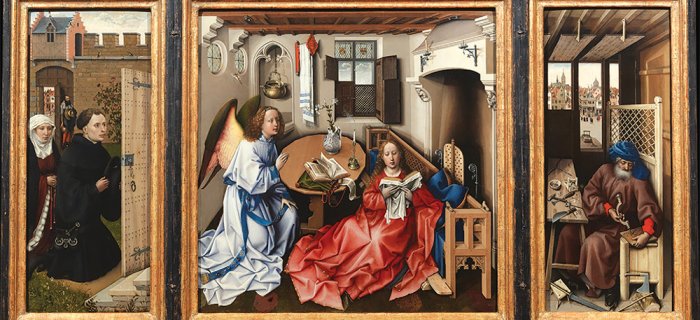
Spike shadows
The theme of triangular shadow regions has many variants, and if Campin is a champion of detail, other artists resorted to less-convincing solutions up to at least the 1800s and even into Gauguin’s Polynesian paintings. Sharp triangle shadows, which we may also call spike shadows, missing a penumbra, are a degenerate pictorial representation of triangle shadows: they have the appearance of a cast shadow from nondiffuse light, and the shape of an anchoring shadow from diffuse light. We can observe spike shadows in Roman mosaics, but also in Renaissance paintings (fig. 16).
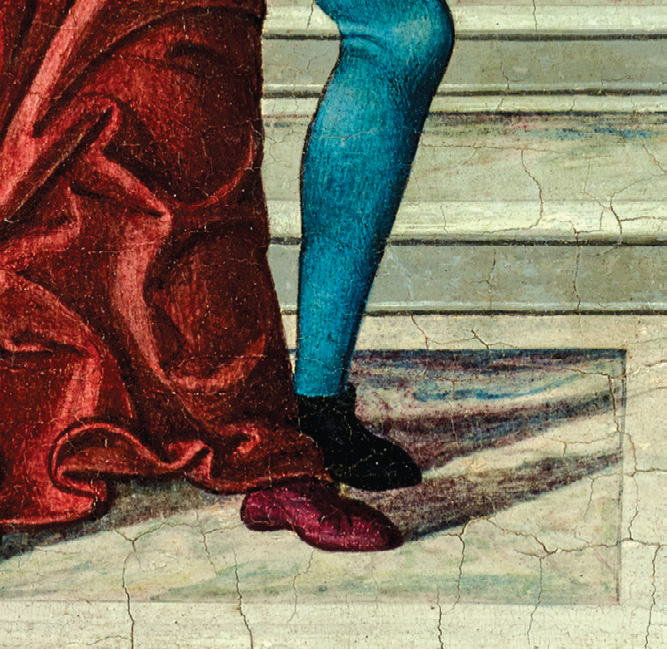
Even more interesting, some shadows are represented as reverse triangle shadows (fig. 17), suggesting that conventionalization plays a role in shaping some shadow representations. Here neither the softness of anchoring shadows is preserved, nor the shape. We can surmise that a propositional representation has mediated the transmission of the craft (“use a triangle to depict a shadow”), and at some point in time, the orientation of the triangle reversed.
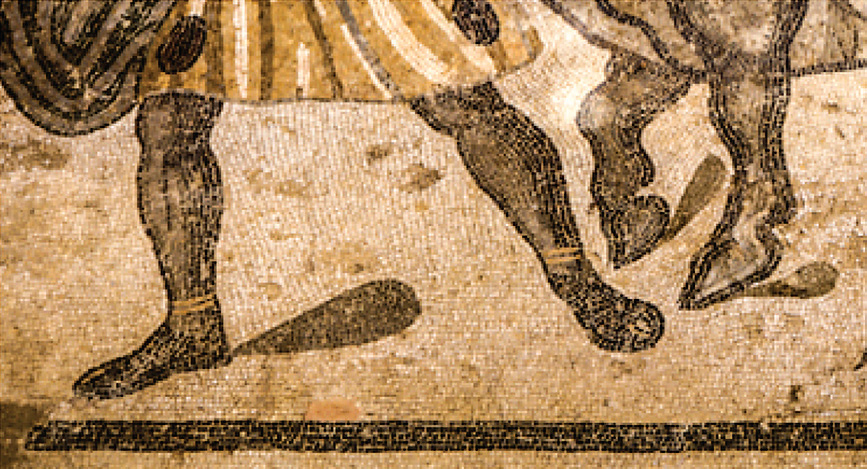
Horseshoe shadows
Horseshoe shadows are born of the attempt to represent the shadow of the pair of human legs that degenerates into a self-standing horseshoe shape (in particular, as the penumbra is absent). Horseshoe shadows have a modern, if limited, life (fig. 18). As with their Roman predecessors (fig. 19), they appear to stretch credibility. Surely we notice that something is wrong with them. The failed experiment indicates some of the limits of acceptable distortions of shadows. And yet we require little interpretive work to state that the painter’s intention here was to draw shadows.
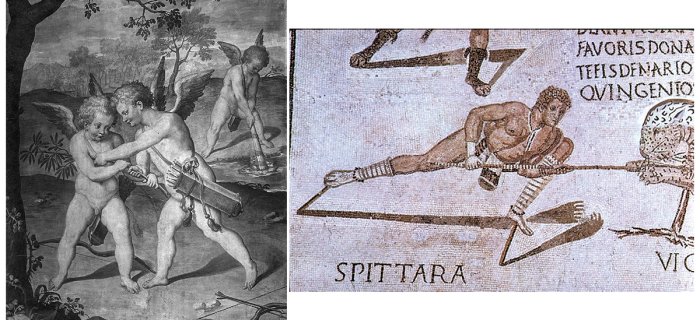
White shadows
You can tinker with shadows in many ways and still not eliminate shadow character, but one thing you should never do: reverse a shadow’s polarity. White shadows on a dark background not only do not exist because of physical laws but would never be perceived as shadows. The shadowed area should always have a luminance that is less than the luminance of the surface that receives them. But what if you have already used the darkest possible color from your palette for the background surface? Mosaic artists in Lugdunum, the ancient Lyon, thought they had some margin for using lighter shadows (fig. 20). Some “canonical” shadows, that is, shadows that are darker than their surroundings, are actually cast by a few objects in the same mosaic where the background is conveniently lighter.
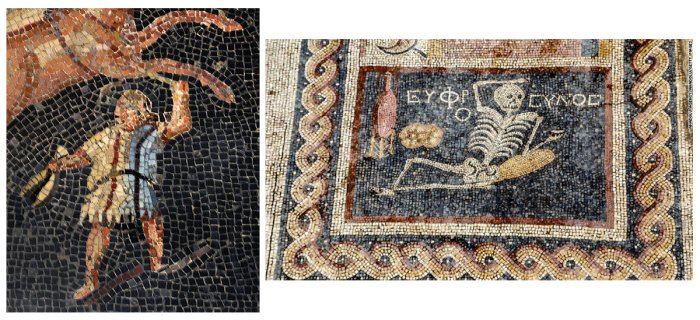
A recently discovered mosaic in Antakya, Turkey, offers a dramatic example of a white shadow (fig. 21). This image from the third century BCE represents a skeleton who advises viewers to enjoy life. Not many shadows of skeletons exist, and the artist used a standard shape of body shadow for the sitter. The light color is once more a necessity given the dark background.
The Volume of Shadows
Conventionalized shadows of Roman mosaics have been variously decorated and enhanced by their makers. The decoration has at times taken the appearance of an attached shadow on the shadow itself, which in turn has conferred volume to the shadow. In figure 22, a whole catalog of ways to create “solid” shadows is displayed in a few square feet of the mosaics at the Villa Romana del Casale. The man’s right leg has two shadows, one of which wraps around and passes in front of a stick that he holds.
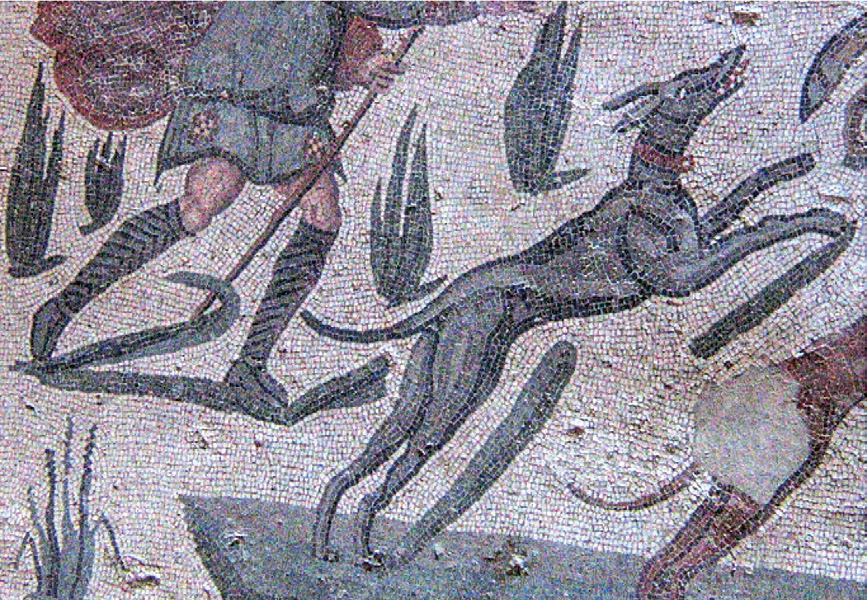
The shadow of his left leg has its own attached shadow, which itself seems to cast a second shadow. Only one of the dog’s rear paws casts a sticklike solid shadow, which is enhanced by an elaborate attached shadow. The right front paw of the same dog casts a more mundane shadow in a direction opposite to the other shadows in the mosaic. One of the characters in the mosaics at the Villa Romana del Casale was even mistakenly identified as a skier, as shadows from his feet seem to take the shape of skis.
Shape, occlusion, and the presence of secondary cast and attached shadows act against our perceptual system’s recognition of certain intended shadows as shadows. Yet, again, it is clear that the artist’s intention was to draw shadows. It would be an interesting research question for art historians to follow the development of these modifications to shadows.
Incoherent, Unrelatable, or Impossible Light Sources
In some cases, it is impossible to relate shadows to any light source at all. In other cases, sources of light are inconsistent. But do we notice the inconsistencies? By 1467, artists such as Fra Carnevale had mastered consistent perspective, but not consistent lighting (fig. 23).
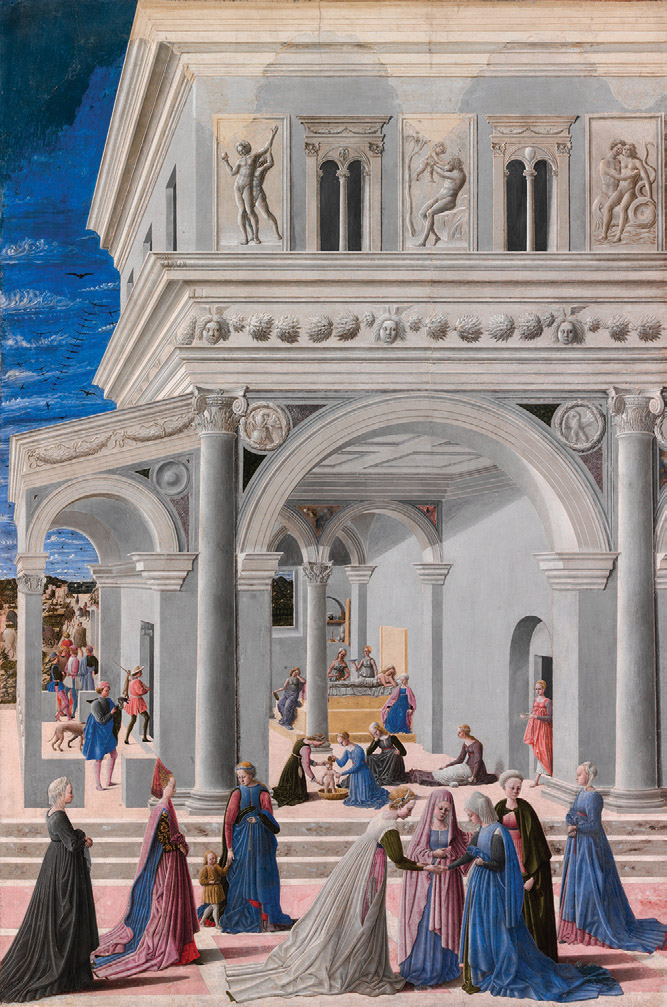
The people in the foreground of Carnevale’s “Birth of the Virgin” cast dark, deep shadows, but those on the piazza above and to the left do not. The alcove on the right is brightly lit, but the only opening in its left wall is a small door. The shadows on the alcove’s right wall rise mysteriously upward, where no light source in the depicted scene could ever make them go. Nonetheless these severe inconsistencies are not evident or jarring to the human viewer.
If we assume that a single source of light is present in a scene, shadows of objects that are parallel to each other are inconsistent if they converge to a point different from the one occupied by the source. In Signorelli’s “Flagellation” (fig. 24), many such points are present.
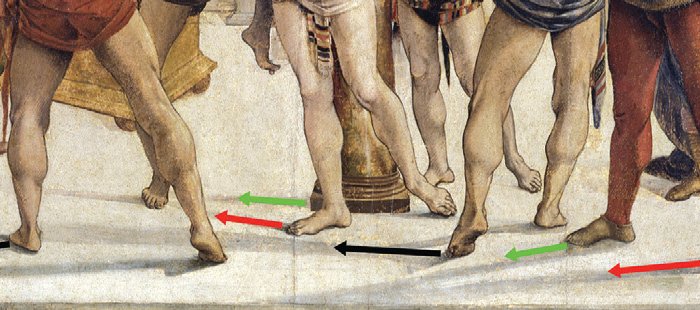
The intarsia from the Studiolo of the Ducal Palace in Gubbio are interesting because of some subtle inconsistencies in the shadows. In one case (fig. 25), the hook holding the hanging cross casts a shadow on the bottom face of the shelf, thereby indicating that light comes from below. But at the same time, the cross’s own shadow is cast at a lower height than the cross, thus indicating that light comes from above.
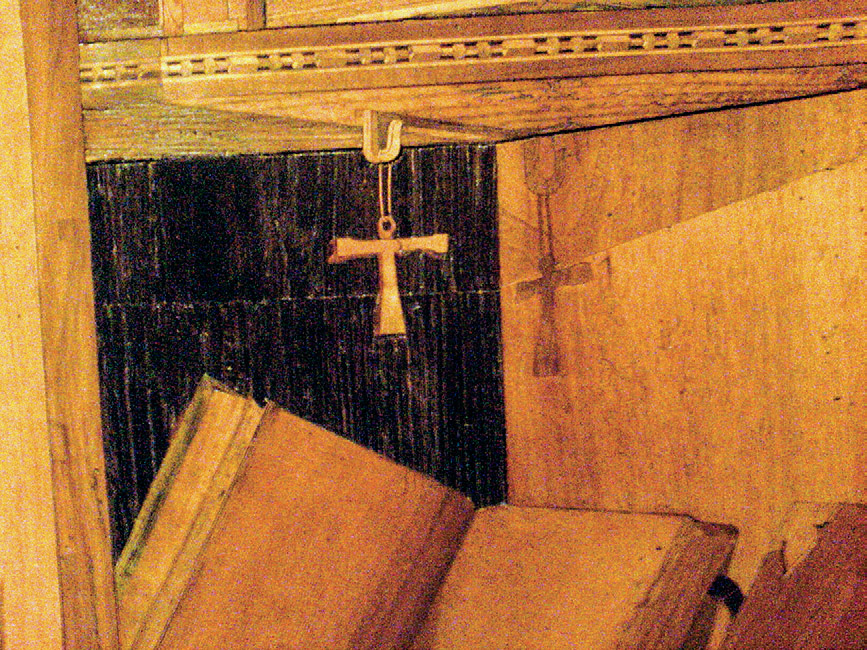
Lone shadows and missing shadows
We should not expect consistency in shadow representation, not even within a single artwork. In artworks, it may happen that some objects cast shadows, whereas others, which should cast them as well, just do not. In some cases, a single object casts a lone shadow in an otherwise shadowless scene. As in a double dissociation pattern, we find also the dual cases of objects that do not cast shadows in scenes where other objects do (fig. 26). It is noteworthy that we do not seem to be particularly concerned by this shadow locality that is inconsistent with the remainder of the illumination in the scene.
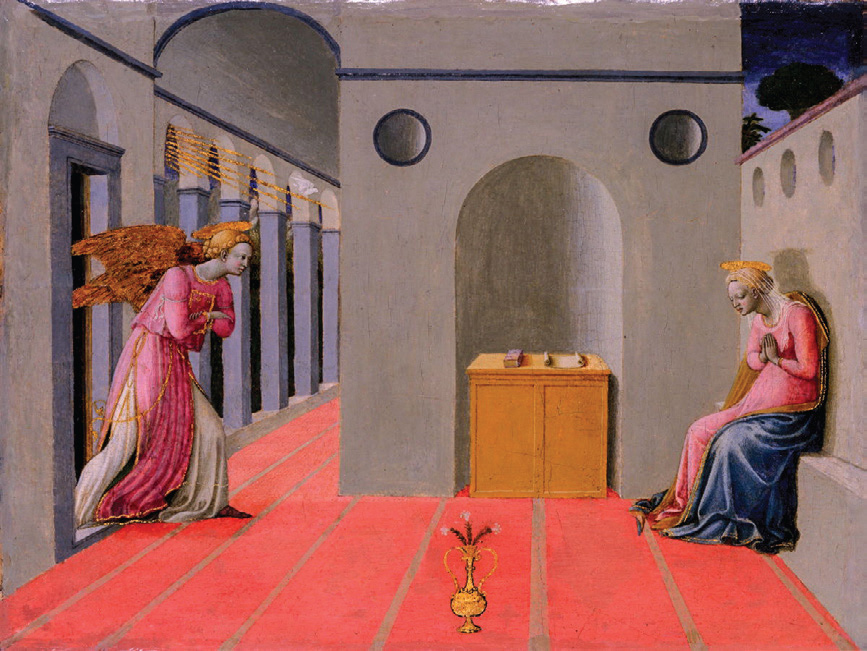
Which objects are allowed to cast shadows?
Opaque physical bodies block light, by definition. In Dante’s “Comedy,” a cast shadow signals the presence of a body (e.g., “Purgatory,” V), as opposed to a soul, which does not block light. In paintings, however, supernatural entities do not always refrain from casting shadows. For example, in the “Annunciation” by Lorenzo Lotto (fig. 27), the angel casts a neat shadow on the floor. But what is an entity that it may cast a shadow? We can identify no intrinsic ontological limitation to the type of entity that casts a shadow: It must just be able to block light.
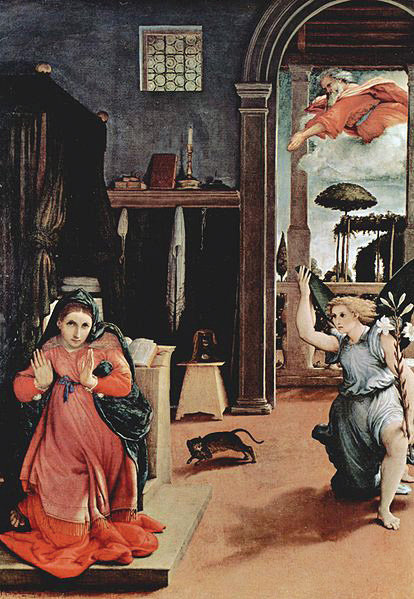
A conceptual paradox is lurking here. To be visible, supernatural entities must reflect light (if they do not emit it). But as a consequence they must be opaque to at least some light, and thus they should cast shadows. The depiction of Dante’s shadow by Signorelli in the Orvieto Cathedral (fig. 28) bears witness to Dante’s bodily nature and betrays him to the (almost) shadowless souls of Purgatory.
It is, moreover, an important constraint that saints and angels, especially flying angels, need to be both visible and visually situated above the ground, in particular, to convince the viewer of their powers. Because shadows confer a sense of presence to objects casting them, painters must negotiate a trade-off between the visual realism provided by shadows and fidelity to the strange metaphysical properties of the objects casting the shadows.

Quasi Taboos
Depicted shadows dislike climbing walls; this is a pictorial disinclination, almost a taboo. Some other disinclinations have helped painters. Shadows seldom appear on human bodies, and in the corpus we examined, we found few self-shadows and few occluded shadows.
No shadows on human bodies
Remember how carpet shadows do not interact adequately with human bodies. More generally, shadows are cast on bodies with great infrequency throughout art history. Violations of this bias are rare, the most spectacular case being the shadow of the Captain’s hand in Rembrandt’s “Night Watch” (fig. 29), and pictorially not very satisfactory. This is to be expected, in a sense. Human bodies are complex objects, and representing them is already an exceedingly difficult pictorial challenge, which includes the challenge of adequately representing patterns of light and shade on them (chiaroscuro). Cast shadows on bodies are not only particularly noisy but also extremely hard to depict. On the other hand, the narrative of the episode may place demands on its visual representation.
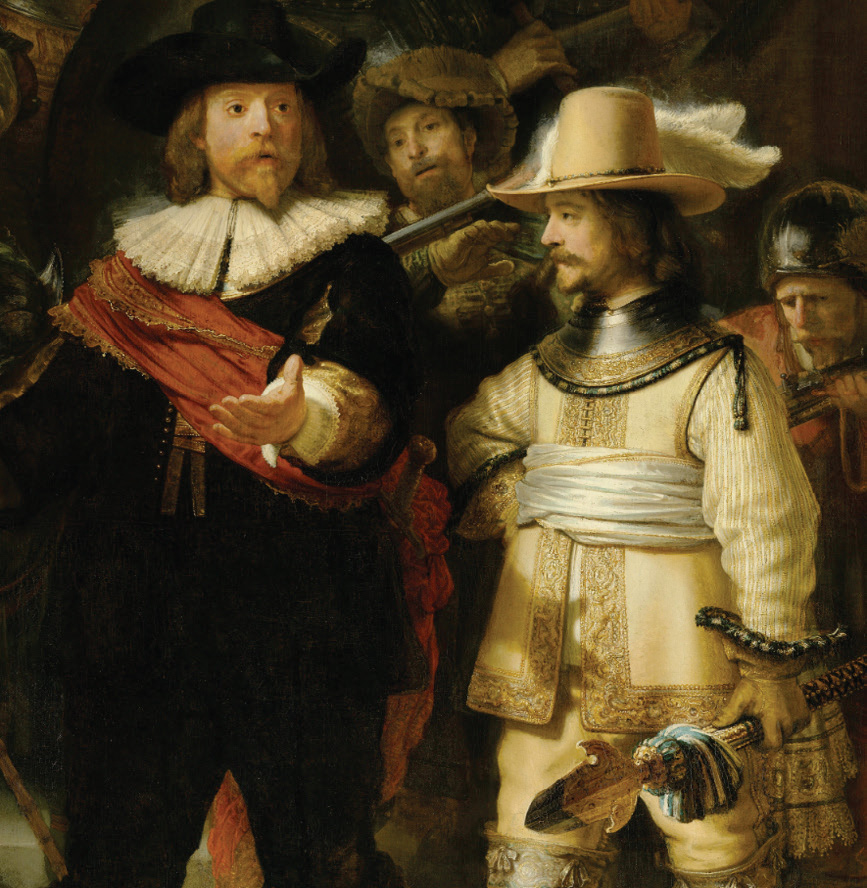
When the solution is relatively simple, and the enhancement obvious, shadows are easier to come by (e.g., shadows of glasses’ frames on cheeks, such as those depicted by Marinus van Reymerswaele (1490–1567) in “The Tax Collectors,” now at the Hermitage in Saint Petersburg). The taboo shadow on human body can usefully be compared with the representation of carpet shadows; but whereas carpet shadows display unsatisfactory interactions with bodies, taboo shadows avoid the confrontation altogether. Thus the implicit recommendation: Do not place cast shadows on bodies.
As we have seen, artists can take many liberties in depicting scenes that appear realistic without having to slavishly follow all the laws of physics. If, instead, our visual systems had to check all the physical properties of shadows, as is often the case in computer vision and computer graphics, they would never arrive at appropriate shadow labeling within a practical amount of time. And artists, in turn, would be constrained to strict photorealism in their representational pieces. Shadows give us a window on vision, and this window has been found and opened by the work of artists and practitioners over the centuries. Indeed, we view artists as fellow cognitive scientists: It is they who made many of the discoveries that contribute to our understanding the complexity of vision.
Roberto Casati is the Director of the Jean Nicod Institute and Professor at EHESS in Paris. He is the coauthor of “Holes and Other Superficialities” and “Parts and Places: The Structures of Spatial Representation,” both published by the MIT Press.
Patrick Cavanagh is a Senior Research Fellow at Glendon College of York University, Toronto.
This article is adapted from their book “The Visual World of Shadows.”



